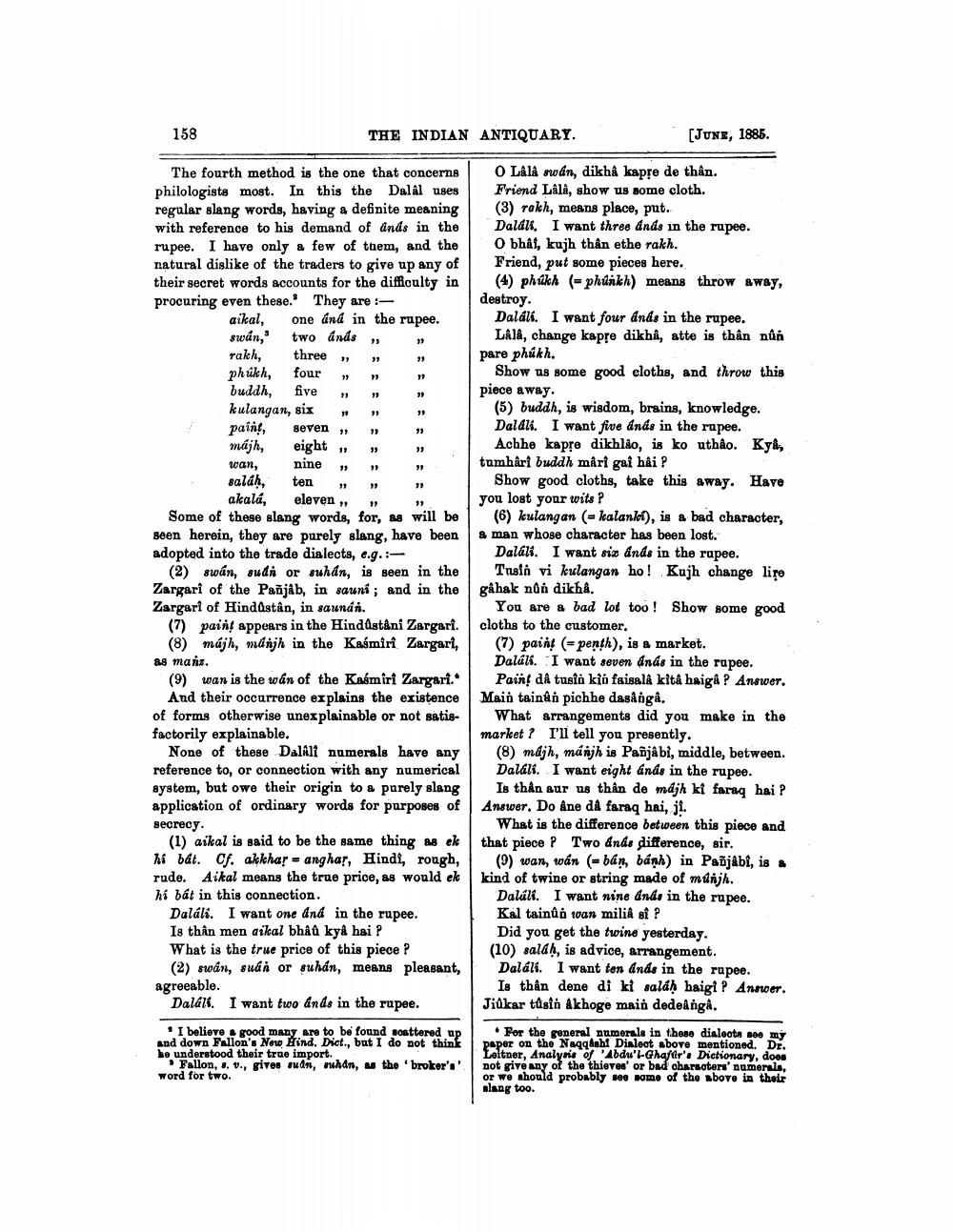________________
158
THE INDIAN ANTIQUARY.
(JUNE, 1885.
The fourth method is the one that concerns philologists most. In this the Dalal uses regular slang words, having a definite meaning with reference to his demand of ands in the rupee. I have only a few of them, and the natural dislike of the traders to give up any of their secret words accounts for the difficulty in procuring even these. They are :
aikal, one and in the rupee. swán, two ands, rakh, three , phukh, four buddh, five kulangan, six paint, seven májh, eight, wan, nine »
» saláh, ten » »
akalá, eleven, Some of these slang words, for, as will be seen herein, they are purely slang, have been adopted into the trade dialects, e.g.:
(2) swán, sudi or suhan, is seen in the Zargari of the Pañjab, in sauní; and in the Zargari of Hindustan, in saunán.
(7) paint appears in the Hindustani Zargari.
(8) májh, manjh in the Kasmiri Zargari, as maiz.
(9) wan is the wán of the Kasmiri Zargari.
And their occurrence explains the existence of forms otherwise unexplainable or not satisfactorily explainable.
None of these Dalili numerals have any reference to, or connection with any numerical system, but owe their origin to a purely slang application of ordinary words for purposes of secrecy.
(1) aikal is said to be the same thing as ek hi bát. Cf. akkhar - anghar, Hindi, rough, rude. Aikal means the true price, as would ek hi bát in this connection. Daláli. I want one and in the rupee. Is thân mến aikal bhân kya hai ? What is the true price of this piece ?
(2) swan, suár or suhan, means pleasant, agreeable.
Dalált. I want two ands in the rupee.
0 Lala vao an, dikha kapre de thân. Friend Lala, show us some cloth. (3) rakh, means place, put. Daldu. I want three ands in the rupee. O bhai, kujh thân ethe rakh. Friend, put some pieces here.
(4) phukh (-phúňkh) means throw away, destroy.
Dalak. I want four ands in the rupee.
LÀlà, change kapre dikhi, atte is thân núi pare phúkh.
Show as some good cloths, and throw this piece away.
(5) buddh, is wisdom, brains, knowledge. Dalali. I want five ands in the rapee.
Achhe kapre dikhlao, is ko uthâo. Kyk, tumhari buddh mari gai hai ?
Show good cloths, take this away. Have you lost your wits ?
(6) kulangan (= kalank), is a bad character, a man whose character has been lost.
Dalak. I want six ands in the rupee.
Trusia vi kulangan ho! Kujh change lire gåhak nun dikha.
You are a bad lot too ! Show some good cloths to the customer.
(7) paint (= penth), is a market. Dalali. I want seven ands in the rupee.
Pain dA tusta kió faisala kita haiga ? Answer. Main tainan pichhe dasångå.
What arrangements did you make in the market? I'll tell you presently.
(8) mdjh, manjh is Panjabi, middle, between. Dalal. I want eight ands in the rupee.
Is thân aur us than de mdjh ki faraq hai ? Answer. Do dne da faraq hai, ji.
What is the difference between this piece and that piece P Two ands difference, sir.
(9) wan, wán (-ban, bánh) in Pañjabi, is & kind of twine or string made of munjh.
Dalüli. I want nine ands in the rupee. Kal tainùó van miliâ si ? Did you get the twine yesterday. (10) salah, is advice, arrangement. Dalali. I want ten ands in the rupee.
Is than dene di ki salah haigi ? Annoer. Jidkar tusin Akhoge main dedeanga.
• I believe a good many are to be found soattered up and down Fallon's New Hind. Dict., but I do not think ho understood their true import.
Fallon, 8. v., gives sudn, ruhan, as the 'broker'.'. word for two.
For the general numerals in these dialecta see my paper on the Naqqashi Dialeat above mentioned. Dr. Leitner, Analysis of Abdu'l-Ghafar'. Dictionary, does not give any of the thieves' or bad characters' numerals or we should probably see some of the above in their alang too.




